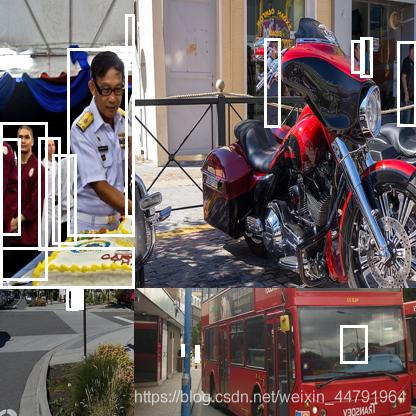[TOC]
线下增强(offline augmentation):事先执行所有转换,实质上会增加数据集的大小,适用于较小的数据集;
线上增强(online augmentation):在送入机器学习之前,在小批量(mini-batch)上执行这些转换;
几何变换类即对图像进行几何变换,包括翻转,旋转,裁剪,变形,缩放等各类操作;
上面的几何变换类操作,没有改变图像本身的内容,它可能是选择了图像的一部分或者对像素进行了重分布。如果要改变图像本身的内容,就属于颜色变换类的数据增强了,常见的包括噪声、模糊、颜色变换、擦除、填充等;
GAN生成数据集,mosaic拼接四张图片等;
2.1 翻转(Flip)
可以对图片进行水平和垂直翻转,从左侧开始,原始图片,水平翻转的图片,垂直翻转的图片。
2.2 旋转(Rotation)
从左向右,图像相对于前一个图像顺时针旋转90度
2.3 缩放比例(Scale)
图像可以向外或向内缩放。向外缩放时,最终图像尺寸将大于原始图像尺寸。大多数图像框架从新图像中剪切出一个部分,其大小等于原始图像。从左到右,原始图像,向外缩放10%,向外缩放20%
2.4 裁剪(Crop)
与缩放不同,我们只是从原始图像中随机抽样一个部分。然后,我们将此部分的大小调整为原始图像大小。这种方法通常称为随机裁剪(random crop)。从左至右,原始图像,左上角裁剪的图像,右下角裁剪的图像。
2.5 移位(Translation)
移位只涉及沿X或Y方向(或两者)移动图像。从左至右,原始图像,向右移位,向上移位。
2.6 调整大小(Resize)
对图像进行缩放,以保证模型具有尺度不变性
2.7 高斯噪声(Gaussian Noise)
神经网络试图学习可能无用的高频特征(大量出现的模式)时,通常会发生过度拟合。具有零均值的高斯噪声基本上在所有频率中具有数据点,从而有效地扭曲高频特征,添加适量的噪音可以增强学习能力。从左至右,原始图形,加入高斯噪声图片,加入盐和胡椒噪声图片
2.8 RGB 颜色扰动(Color distortion)& 调整亮度,对比度,饱和度,色调(brightness, contrast, saturation, and hue)
2.9 随机擦除(Random erase、CutOut)
对图像中随机选取一个矩形区域用特定的值(随机值或者数据均值)进行覆盖
2.10 Mixup
对两张图像和对应标签进行线性叠加
2.11 CutMix
在Mixup和CutOut的基础上,将图像中的某一区域去除,填充成另一图像
2.12 GAN
风格转换、生成fake图片
2.13 Mosaic
mosaic 利用了四张图片拼接,丰富检测物体的背景,而且在BN计算的时候一下子会计算四张图片的数据
参考资料:
【1】Data Augmentation | How to use Deep Learning when you have Limited Data
【2】知乎-深度学习中的数据增强方法都有哪些?
【3】CSDN-深度学习数据增强方法总结
基于SSD的数据增强,代码如下:
import torchvision.transforms.functional as FT1.flip
def flip(image, boxes):
# Flip image
new_image = FT.hflip(image)
# Flip boxes
new_boxes = boxes
new_boxes[:, 0] = image.width - boxes[:, 0] - 1
new_boxes[:, 2] = image.width - boxes[:, 2] - 1
new_boxes = new_boxes[:, [2, 1, 0, 3]]
return new_image, new_boxes2.resize
def resize(image, boxes, dims=(300, 300), return_percent_coords=True):
# Resize image
new_image = FT.resize(image, dims)
# Resize bounding boxes
old_dims = torch.FloatTensor([image.width, image.height, image.width, image.height]).unsqueeze(0)
new_boxes = boxes / old_dims # percent coordinates
if not return_percent_coords:
new_dims = torch.FloatTensor([dims[1], dims[0], dims[1], dims[0]]).unsqueeze(0)
new_boxes = new_boxes * new_dims
return new_image, new_boxes3.padding
def expand(image, boxes, filler):
"""Helps to learn to detect smaller objects.
"""
original_h = image.size(1)
original_w = image.size(2)
max_scale = 4
scale = random.uniform(1, max_scale)
new_h = int(scale * original_h)
new_w = int(scale * original_w)
# Create such an image with the filler
filler = torch.FloatTensor(filler) # (3)
new_image = torch.ones((3, new_h, new_w), dtype=torch.float) * filler.unsqueeze(1).unsqueeze(1)
# Place the original image at random coordinates in this new image (origin at top-left of image)
left = random.randint(0, new_w - original_w)
right = left + original_w
top = random.randint(0, new_h - original_h)
bottom = top + original_h
new_image[:, top:bottom, left:right] = image
# Adjust bounding boxes' coordinates accordingly
new_boxes = boxes + torch.FloatTensor([left, top, left, top]).unsqueeze(0)
return new_image, new_boxes4.Distort brightness, contrast, saturation, and hue
def photometric_distort(image):
new_image = image
distortions = [FT.adjust_brightness,
FT.adjust_contrast,
FT.adjust_saturation,
FT.adjust_hue]
random.shuffle(distortions)
for d in distortions:
if random.random() < 0.5:
if d.__name__ is 'adjust_hue':
adjust_factor = random.uniform(-18 / 255., 18 / 255.)
else:
adjust_factor = random.uniform(0.5, 1.5)
# Apply this distortion
new_image = d(new_image, adjust_factor)
return new_image5.random crop
def random_crop(image, boxes, labels, difficulties):
original_h = image.size(1)
original_w = image.size(2)
# Keep choosing a minimum overlap until a successful crop is made
while True:
# Randomly draw the value for minimum overlap
min_overlap = random.choice([0., .1, .3, .5, .7, .9, None]) # 'None' refers to no cropping
# If not cropping
if min_overlap is None:
return image, boxes, labels, difficulties
max_trials = 50
for _ in range(max_trials):
# Crop dimensions must be in [0.3, 1] of original dimensions
min_scale = 0.3
scale_h = random.uniform(min_scale, 1)
scale_w = random.uniform(min_scale, 1)
new_h = int(scale_h * original_h)
new_w = int(scale_w * original_w)
# Aspect ratio has to be in [0.5, 2]
aspect_ratio = new_h / new_w
if not 0.5 < aspect_ratio < 2:
continue
# Crop coordinates (origin at top-left of image)
left = random.randint(0, original_w - new_w)
right = left + new_w
top = random.randint(0, original_h - new_h)
bottom = top + new_h
crop = torch.FloatTensor([left, top, right, bottom]) # (4)
# Calculate Jaccard overlap between the crop and the bounding boxes
overlap = find_jaccard_overlap(crop.unsqueeze(0),boxes)
overlap = overlap.squeeze(0)
if overlap.max().item() < min_overlap:
continue
# Crop image
new_image = image[:, top:bottom, left:right] # (3, new_h, new_w)
# Find centers of original bounding boxes
bb_centers = (boxes[:, :2] + boxes[:, 2:]) / 2. # (n_objects, 2)
# Find bounding boxes whose centers are in the crop
centers_in_crop = (bb_centers[:, 0] > left) * (bb_centers[:, 0] < right) * (bb_centers[:, 1] > top) * (bb_centers[:, 1] < bottom)
# If not a single bounding box has its center in the crop, try again
if not centers_in_crop.any():
continue
# Discard bounding boxes that don't meet this criterion
new_boxes = boxes[centers_in_crop, :]
new_labels = labels[centers_in_crop]
new_difficulties = difficulties[centers_in_crop]
# Calculate bounding boxes' new coordinates in the crop
new_boxes[:, :2] = torch.max(new_boxes[:, :2], crop[:2])
new_boxes[:, :2] -= crop[:2]
new_boxes[:, 2:] = torch.min(new_boxes[:, 2:], crop[2:])
new_boxes[:, 2:] -= crop[:2]
return new_image, new_boxes, new_labels, new_difficulties def get_data_with_Mosaic(self, index, image, boxes, labels, difficulties):
"""loads images in a mosaic
"""
img_size = 300
image_s4 = Image.new('RGB', (img_size*2, img_size*2), (255, 255, 255))
boxes_s4 = torch.FloatTensor([])
labels_s4 = labels
difficulties_s4 = difficulties
# 3 additional image indices
indices = [index] + [random.randint(0, self.num_samples - 1) for _ in range(3)]
for i, index in enumerate(indices):
image = Image.open(self.images[index], mode='r')
image = image.convert('RGB')
objects = self.objects[index]
boxes = torch.FloatTensor(objects['boxes'])
labels = torch.LongTensor(objects['labels'])
difficulties = torch.ByteTensor(objects['difficulties'])
new_image, new_boxes = resize(image, boxes, dims=(img_size, img_size), return_percent_coords=False)
# place img in img4
if i == 0: # top left
image_s4.paste(new_image, (0, img_size))
box = new_boxes+torch.FloatTensor([0, img_size, 0, img_size]).unsqueeze(0)
elif i == 1: # top right
labels_s4 = torch.cat([labels_s4,labels])
difficulties_s4 = torch.cat([difficulties_s4,difficulties])
image_s4.paste(new_image, (img_size, img_size))
box = new_boxes + torch.FloatTensor([img_size, img_size, img_size, img_size]).unsqueeze(0)
elif i == 2: # bottom left
labels_s4 = torch.cat([labels_s4, labels])
difficulties_s4 = torch.cat([difficulties_s4, difficulties])
image_s4.paste(new_image, (0, 0))
box = new_boxes
elif i == 3: # bottom right
labels_s4 = torch.cat([labels_s4, labels])
difficulties_s4 = torch.cat([difficulties_s4, difficulties])
image_s4.paste(new_image, (img_size, 0))
box = new_boxes + torch.FloatTensor([img_size, 0, img_size, 0]).unsqueeze(0)
boxes_s4 = torch.cat([boxes_s4, box], dim=0)
return image_s4, boxes_s4, labels_s4, difficulties_s4基于SSD300的框架的检验:
(PS:因为实验室服务器远程连接的人数太多了,连不上,所以个人电脑CPU运行的代码,运行时间一个epoch都是四个多小时,测试时间也是四五个小时,所以进行了简单的检验,主要是对Mosaic方法的检验,初始实验一天,对照实验一天,中间还悲惨的跑了一天的测试发现结果不理想,原来是mosaic的数据框标注反了,后面可视化mosaic才看到,可视化的结果也在下面)
epoch:2,batch_size:8,数据集:VOC2007
初始实验:有正常的flip,padding,random crop等,2个epoch之后,结果如下,mAP:0.064,非常低,因为跑的轮数太少了;
在前面的基础加上Mosaic方法后,同样2个epoch后,mAP:0.099,有所进步,结果如下,因为SSD300输入是固定的300x300,感觉Mosaic和前面的padding一样,将物体的尺寸缩小了,同时也有利于小物体的检测;
Mosaic的可视化:
参考资料:
【1】Github:a-PyTorch-Tutorial-to-Object-Detection
【2】YOLOv4: Optimal Speed and Accuracy of Object Detection
1.平时数据增强都是直接利用pytorch 中 torchvision.transforms 几个数据增强函数,小的比赛中基本上都没怎么用数据增强,没有太多的关注这方面。其实也是很有启发性的,比如Mixup的思路和我们TIP在投论文的水下数据的增强网络大致想法是一样的,我们还利用了GAN更好的生成数据,当时我是受了显著性目标检测的启发想到的,不过YOLOv4今年4月份才出来;
2.本科时候主要还是看的比较多,虽然课内的所有大作业和各种比赛的代码核心都是自己,但是因为时间(大部分时间得刷课内成绩和奖学金)和算力卡(实验室资源留给本科生的不多)的限制,很少动手去复现和实践CV方面的任务,大部分都是跑实验之类。所以也是很想读博,希望给自己一个很长的时间去提升自己。
3.现在成型的框架太多了,都是一个团队很久的积淀,也有MMdetection等工具,很疑惑好像自己个人造轮子写出来或者复现的东西有点差劲




















